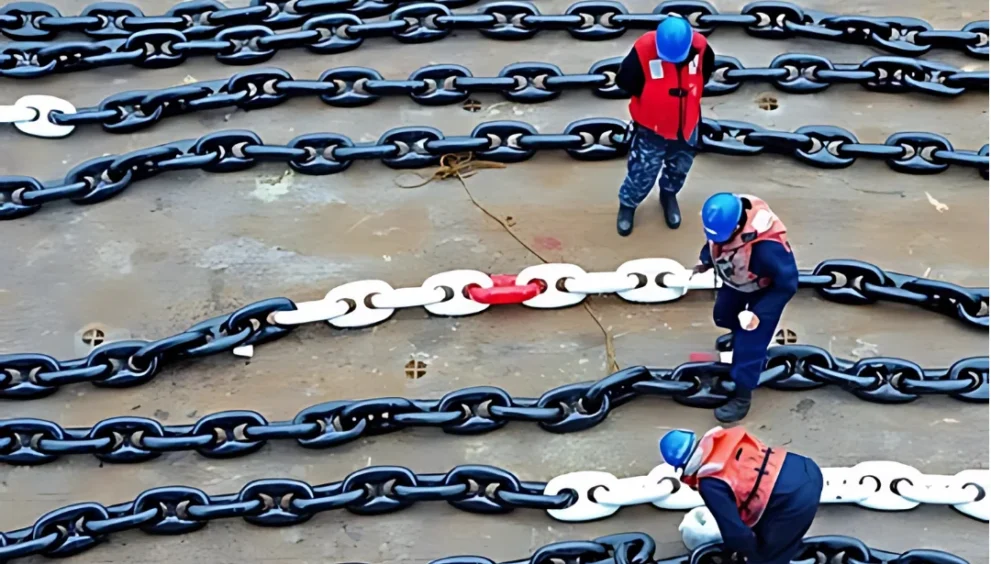Markings and Anchor Chain: Everything You Want to Know
One of the most critical jobs on a ship is anchoring, and a safe and efficient operation relies on familiarization with the anchor chains and their markings. A crucial aspect of anchoring operations are the markings on the anchor chain, which allow the crew to keep track of how much chain is being let out or picked up. We’re going to discuss everything you need to know about anchor chain markings within this web log, including their significance and how best to deal with them.
What Are Anchor Chain Markings?
Anchor chain marks are typically painted or engraved markings on the chain that assist personnel in determining how much chain is heaved or sent during an anchoring operation. Despite the fact that the visibility of such markings may vary, they typically follow a pattern of color coding or symbols to represent different chain intervals, usually in shackles, a length unit used to quantify chain.
Typical Marking Arrangements:
The markings on the anchor chain will typically have a consistent colour scheme, although again these may vary based on the vessel or particular requirements.The most typical framework is as follows:
-Markings Every Shackle: Every few shackles, you’ll typically discover a painted marking (regularly in shinning colours like red, green, or yellow) that corresponds to a particular length of chain.The crew can more effortlessly see how much chain is out thanks to these colors.
-Markings for Specific Lengths: Certain ships will also mark specific lengths on the chain, like 10 or 20 meters, as well as shackles. The crew will use this to determine how much chain has been dropped at any one time.
-Identification Markings: In addition to the typical measurements, some vessels further label the last several shackles in a contrasting colour or pattern to indicate that the anchor is on the seabed or to indicate the chain limit.
Why Are These Markings Important?
Properly marked anchor chains are critical to safe and efficient anchoring. In the absence of markings, the crew would have no way of knowing how much chain is let out or heaved in, and as a result can determine incorrect scope ratios and experience anchor dragging.
-Visibility and Control: The colour markings are easily visible in sunlight, which allows it to be easier for crew members to see visually how much chain is deployed. This allows for much better control of the ship’s position in relation to the anchor.
-Safety: With the appropriate markings, the crew can ensure that the appropriate amount of chain is being deployed, neither over-anchoring nor under-anchoring, both of which might lead to an unsafe anchor or damage to equipment.
-Efficiency: Decisions are facilitated in a timely manner due to accurate marking systems. Markings assist the crew in staying focused and ensure that the anchor chain is handled accordingly, whether they are lowering or lifting the anchor.
Advantages and Disadvantages of Painted Markings:
While painted markings are the most widely used method of showing chain length, there are some pros and cons to consider
Advantages:
Easy to See: Even under low light conditions, characteristic paint colors such as red, green, and yellow are very visible.
Quick Reference: Anchoring procedures are quickened and simplified through markings on the chain, providing a ready visual reference for tracking deployment.
Affordable: In comparison with other marking options such as metal stamps or engraving, painting is a relatively affordable method for distinguishing chains.
Disadvantages:
Wear and Tear: With time, it might become increasingly inconvenient to observe the markings because paint can wear off due to exposure to wind, saltwater, and abrasion against the chain. Regular maintenance is necessary to ensure the markings are still visible.
Problems with Accurate Tracking: If paint wears away, it might be difficult to determine how much chain is out, which can lead to errors and delays in operations.
Options Other than Painted Markings
There are some options you can consider if painted markings unavoidably become less effective through wear:
Engraved Markings: The chain can be engraved at intervals instead of paint. This would make the markings more resistant to wear and more durable, but engraving can take a lot of time and be costly.
Metal labels or tags attached to the chain are employed by some ships. Compared to paint, these are not as prone to fading and can be engraved with lengths or codes.
Reflective Tape: In other instances, reflective tape might be employed, which can prove particularly valuable in terms of visibility at night-time. This is an option that offers the visibility of paint together with greater resilience.
Automatic Sensors: On newer vessels, automatic sensors and monitoring systems may monitor the quantity of chain laid in real-time.Independent of relying on physical markings, these systems provide accurate information.
Concluding Remarks:
Anchor chains and markings are central to the anchoring process. Familiarization with your ship’s marking framework allows for safe and effective anchoring manoeuvres. Maintaining the markings conspicuous and clear is necessary for effective operations, using painted markings, engraved labels, or reflective tapes
You can be sure of your chain deployment and recovery accuracy, keeping the ship secure and avoiding any problems during anchoring, by regularly inspecting the marks to ensure that they are in good condition without wear or damage.


